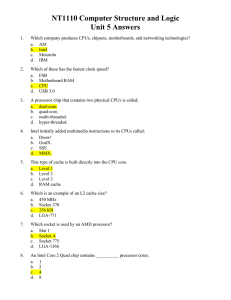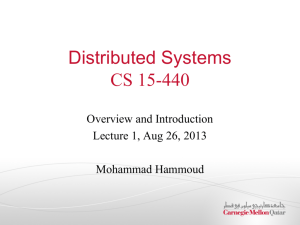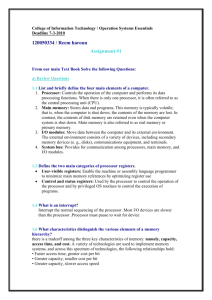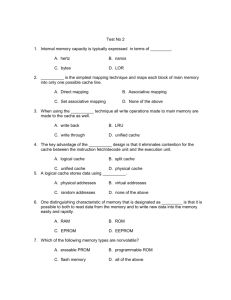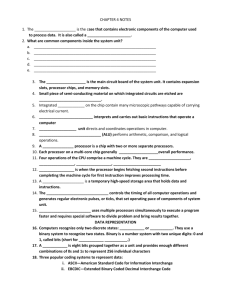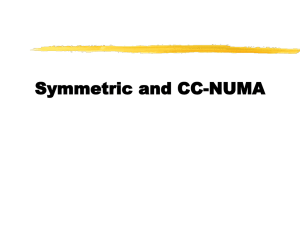The processor (CPU, for Central Processing Unit)
advertisement
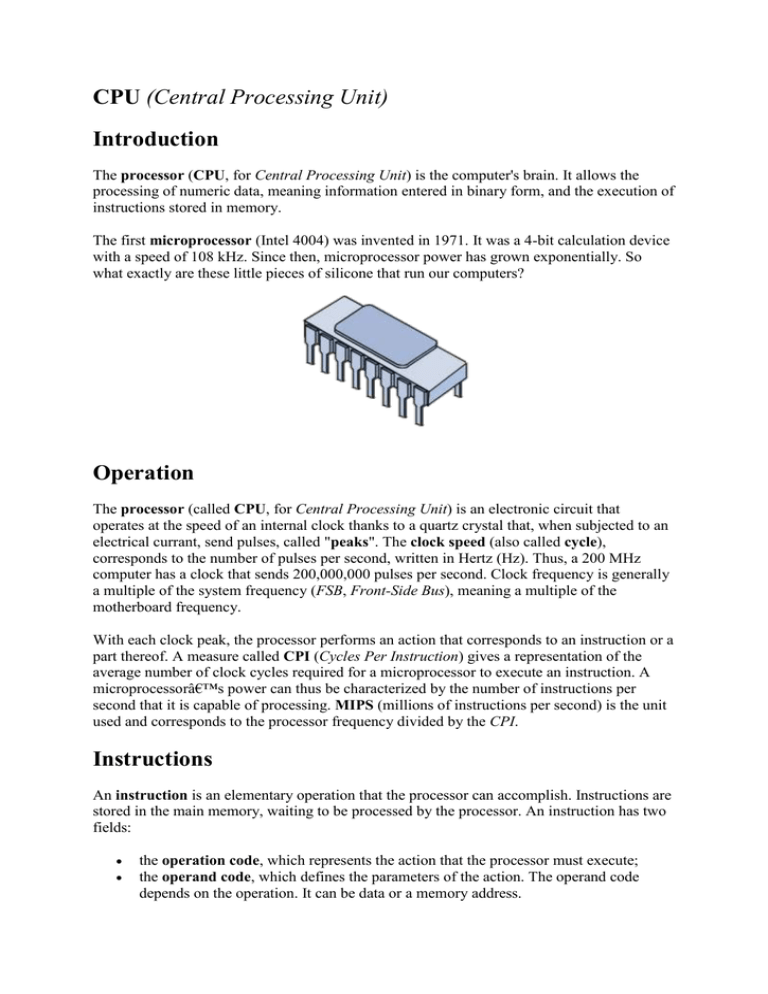
CPU (Central Processing Unit) Introduction The processor (CPU, for Central Processing Unit) is the computer's brain. It allows the processing of numeric data, meaning information entered in binary form, and the execution of instructions stored in memory. The first microprocessor (Intel 4004) was invented in 1971. It was a 4-bit calculation device with a speed of 108 kHz. Since then, microprocessor power has grown exponentially. So what exactly are these little pieces of silicone that run our computers? Operation The processor (called CPU, for Central Processing Unit) is an electronic circuit that operates at the speed of an internal clock thanks to a quartz crystal that, when subjected to an electrical currant, send pulses, called "peaks". The clock speed (also called cycle), corresponds to the number of pulses per second, written in Hertz (Hz). Thus, a 200 MHz computer has a clock that sends 200,000,000 pulses per second. Clock frequency is generally a multiple of the system frequency (FSB, Front-Side Bus), meaning a multiple of the motherboard frequency. With each clock peak, the processor performs an action that corresponds to an instruction or a part thereof. A measure called CPI (Cycles Per Instruction) gives a representation of the average number of clock cycles required for a microprocessor to execute an instruction. A microprocessor’s power can thus be characterized by the number of instructions per second that it is capable of processing. MIPS (millions of instructions per second) is the unit used and corresponds to the processor frequency divided by the CPI. Instructions An instruction is an elementary operation that the processor can accomplish. Instructions are stored in the main memory, waiting to be processed by the processor. An instruction has two fields: the operation code, which represents the action that the processor must execute; the operand code, which defines the parameters of the action. The operand code depends on the operation. It can be data or a memory address. Operation Code Operand Field The number of bits in an instruction varies according to the type of data (between 1 and 4 8bit bytes). Instructions can be grouped by category, of which the main ones are: Memory Access: accessing the memory or transferring data between registers. Arithmetic Operations: operations such as addition, subtraction, division or multiplication. Logic Operations: operations such as AND, OR, NOT, EXCLUSIVE NOT, etc. Control: sequence controls, conditional connections, etc. Registers When the processor executes instructions, data is temporarily stored in small, local memory locations of 8, 16, 32 or 64 bits called registers. Depending on the type of processor, the overall number of registers can vary from about ten to many hundreds. The main registers are: the accumulator register (ACC), which stores the results of arithmetic and logical operations; the status register (PSW, Processor Status Word), which holds system status indicators (carry digits, overflow, etc.); the instruction register (RI), which contains the current instruction being processed; the ordinal counter (OC or PC for Program Counter), which contains the address of the next instruction to process; the buffer register, which temporarily stores data from the memory. Cache Memory Cache memory (also called buffer memory) is local memory that reduces waiting times for information stored in the RAM (Random Access Memory). In effect, the computer's main memory is slower than that of the processor. There are, however, types of memory that are much faster, but which have a greatly increased cost. The solution is therefore to include this type of local memory close to the processor and to temporarily store the primary data to be processed in it. Recent model computers have many different levels of cache memory: Level one cache memory (called L1 Cache, for Level 1 Cache) is directly integrated into the processor. It is subdivided into two parts: o the first part is the instruction cache, which contains instructions from the RAM that have been decoded as they came across the pipelines. o the second part is the data cache, which contains data from the RAM and data recently used during processor operations. Level 1 caches can be accessed very rapidly. Access waiting time approaches that of internal processor registers. Level two cache memory (called L2 Cache, for Level 2 Cache) is located in the case along with the processor (in the chip). The level two cache is an intermediary between the processor, with its internal cache, and the RAM. It can be accessed more rapidly than the RAM, but less rapidly than the level one cache. Level three cache memory (called L3 Cache, for Level 3 Cache) is located on the motherboard. All these levels of cache reduce the latency time of various memory types when processing or transferring information. While the processor works, the level one cache controller can interface with the level two controller to transfer information without impeding the processor. As well, the level two cache interfaces with the RAM (level three cache) to allow transfers without impeding normal processor operation. Control Signals Control signals are electronic signals that orchestrate the various processor units participating in the execution of an instruction. Control signals are sent using an element called a sequencer. For example, the Read / Write signal allows the memory to be told that the processor wants to read or write information. Functional Units The processor is made up of a group of interrelated units (or control units). Microprocessor architecture varies considerably from one design to another, but the main elements of a microprocessor are as follows: A control unit that links the incoming data, decodes it, and sends it to the execution unit:The control unit is made up of the following elements: o sequencer (or monitor and logic unit) that synchronizes instruction execution with the clock speed. It also sends control signals; o ordinal counter that contains the address of the instruction currently being executed; o instruction register that contains the following instruction. An execution unit (or processing unit) that accomplishes tasks assigned to it by the instruction unit. The execution unit is made of the following elements: o The arithmetical and logic unit (written ALU). The ALU performs basic arithmetical calculations and logic functions (AND, OR, EXCLUSIVE OR, etc.); o The floating point unit (written FPU) that performs partial complex calculations which cannot be done by the arithmetical and logic unit. o The status register; o The accumulator register. A bus management unit (or input-output unit) that manages the flow of incoming and outgoing information and that interfaces with system RAM; The diagram below gives a simplified representation of the elements that make up the processor (the physical layout of the elements is different than their actual layout):
